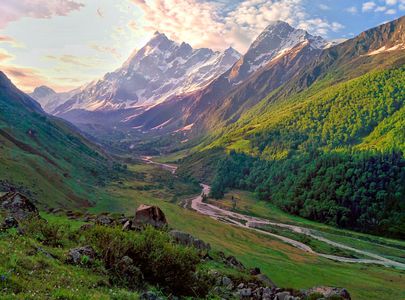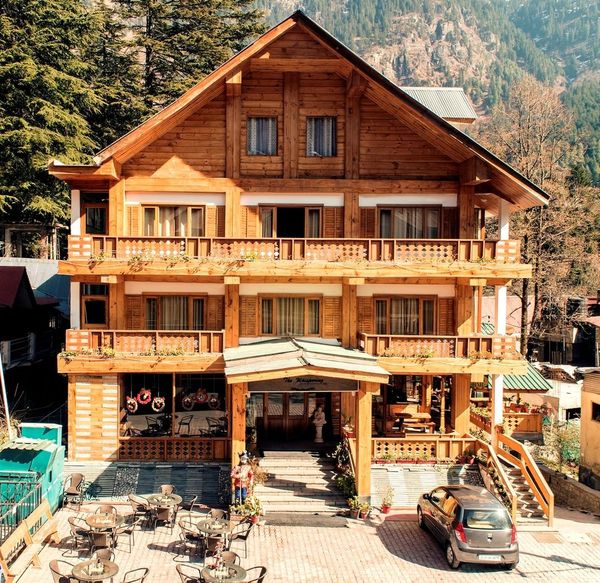Into the Valley of Gods: Har Ki Dun Trek with Camping Adventures
 Palakshi Meharwal
13 May, 2025
11 mins read
20
Palakshi Meharwal
13 May, 2025
11 mins read
20

Nestled deep within the cradle of the Garhwal Himalayas, the Har Ki Dun trek is often described as a journey into the “Valley of Gods.†A perfect blend of mythological lore, alpine meadows, and remote village culture, this trek offers one of the most scenic and rewarding hiking experiences in the Indian Himalayas. Whether you're a seasoned trekker or a curious adventurer, Har Ki Dun invites you into a world where nature and legend walk hand in hand.
Overview of the Har Ki Dun Trek
Located in the Uttarkashi district of Uttarakhand, the Har Ki Dun valley sits at an altitude of around 3,566 meters (11,700 feet). It forms part of the Govind Pashu Vihar National Park and Wildlife Sanctuary, a protected area known for its rich biodiversity and untouched landscapes. The trek covers approximately 45–50 kilometers over seven to nine days, depending on the itinerary and weather conditions.
The trail meanders through ancient hamlets like Osla and Seema, offering glimpses into the traditional lifestyle of the region’s indigenous communities. Along the way, trekkers are treated to snow-clad peaks, coniferous forests, cascading streams, and the rhythmic sounds of Himalayan birds.
Mythology and Cultural Significance
Har Ki Dun, which translates to “Valley of God,†is steeped in mythology. According to legends, this was the route taken by the Pandavas from the Mahabharata on their final journey to heaven. The village of Osla even has a temple dedicated to Duryodhana, the controversial antagonist of the epic, reflecting a cultural perspective rarely seen elsewhere in India.
This intertwining of myth and reality gives the trek a spiritual undertone, often attracting pilgrims, history enthusiasts, and cultural travelers alongside nature lovers.
The Camping Experience: A Night Under the Stars
One of the most enriching aspects of the Har Ki Dun trek is the opportunity to camp in pristine wilderness. Most itineraries include overnight stays at key locations like Kalkattiyadhar, Boslo, and the Har Ki Dun valley itself.
Here’s what makes the camping experience special:
Stunning Landscapes:
Campers wake up to views of snow-draped peaks like Swargarohini, Bandarpoonch, and Black Peak. Morning light on these mountains can be breathtaking, ideal for photography and quiet reflection.
Peaceful Seclusion:
The valley is relatively less crowded compared to popular treks like Roopkund or Kedarkantha. This solitude enhances the camping experience, allowing trekkers to truly connect with nature.
Starlit Skies:
Clear, unpolluted skies offer exceptional stargazing opportunities. On a moonless night, the Milky Way is often visible, creating a celestial canopy above the tents.
Campfire Bonding:
Evenings at camp often revolve around a warm fire. Stories are shared, songs are sung, and hot meals are enjoyed in good company—fostering a camaraderie that’s unique to multi-day treks.
Route Breakdown: From Sankri to Har Ki Dun
Most Har Ki Dun treks begin from Sankri, a small village accessible by road from Dehradun. Here's a typical route layout:
- Day 1: Dehradun to Sankri (200 km by road)
- Day 2: Sankri to Taluka (via vehicle), trek to Seema/Osla
- Day 3: Seema/Osla to Har Ki Dun
- Day 4: Exploration day at Har Ki Dun (possible day trek to Jaundhar Glacier)
- Day 5: Har Ki Dun to Osla/Seema
- Day 6: Return trek to Taluka and drive back to Sankri
- Day 7: Sankri to Dehradun
This route can vary depending on weather and group capability. Some operators may include acclimatization days or explore alternate paths like the Ruinsara Tal trail for added adventure.
Biodiversity and Natural Beauty
The valley falls within a conservation area, and the ecological richness here is profound. You might encounter Himalayan Monals, golden eagles, langurs, or even signs of elusive snow leopards.
Spring and early summer witness a riot of wildflowers, while post-monsoon months bring verdant meadows and clear skies. In winter (December–March), the valley is blanketed in snow, transforming the trek into a challenging but visually stunning experience.
Best Time to Visit
- Spring/Summer (April–June): Moderate weather, blooming flora, good visibility
- Post-monsoon (September–November): Crisp skies, vibrant landscapes
- Winter (December–March): Snow trek conditions, extreme cold
Each season offers a distinct experience. For first-time trekkers, April to June or September to November are considered optimal.
Essentials to Carry
Given the remote nature of the Har Ki Dun valley, preparation is key. Recommended essentials include:
- High-ankle trekking shoes with good grip
- Layered clothing (thermal wear, fleece, waterproof jackets)
- Sleeping bags (provided by operators, but personal liners are suggested)
- Trekking poles, water bottles, energy snacks
- Basic medical kit, including altitude sickness medication
- Camera and power bank (limited or no charging points)
- Government-issued ID for permits
For eco-conscious trekkers, minimizing plastic usage and adhering to Leave No Trace principles is essential to preserving the region’s purity.
Permits and Guided Treks
Trekkers need to obtain permission from the Forest Department, and guided tours typically include these permits in their packages. Most treks are organized by adventure travel companies registered with the Uttarakhand Tourism Board. Choosing a reputable and experienced guide not only ensures safety but also deepens the experience with cultural insights and environmental education.
Difficulty Level: Moderate
The Har Ki Dun trek is categorized as a moderate-grade trek. It’s suitable for beginners with basic fitness levels, though prior preparation involving cardio and stamina training is recommended. The terrain includes gradual ascents, river crossings, and the occasional steep patch.
What makes it beginner-friendly is the relatively low altitude (by Himalayan standards) and the presence of well-established trails. That said, weather changes and altitude gains can pose challenges, especially for the unprepared.
Why Choose Har Ki Dun Over Other Treks?
- Rich in culture and mythology
- Balanced difficulty—accessible yet adventurous
- Unique flora and fauna
- Less commercialized than other treks
- Year-round trekking opportunities (depending on experience level)
Har Ki Dun provides an immersive experience that’s as much about the people and stories as it is about the peaks and trails. The slow pace, combined with its blend of natural and spiritual elements, makes it more than just a trek—it’s a pilgrimage through nature.
Final Thoughts
The Har Ki Dun trek is more than a physical journey through the Himalayas—it's a passage into timeless landscapes, ancient myths, and moments of serene introspection. Whether you’re pitching your tent beside a gurgling stream or walking through fields of alpine blooms, every step in this valley resonates with the echoes of the divine and the untamed.
Written By:
Palakshi Meharwal



Hotels at your convenience
Now choose your stay according to your preference. From finding a place for your dream destination or a mere weekend getaway to business accommodations or brief stay, we have got you covered. Explore hotels as per your mood.





